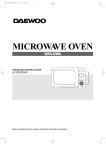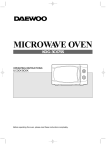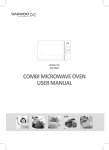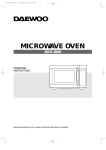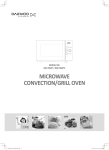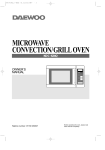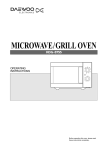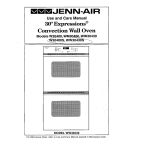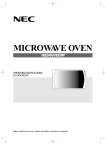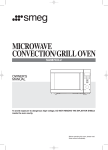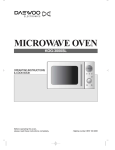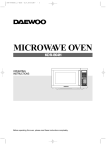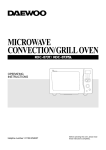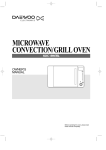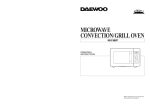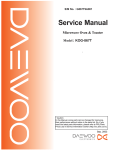Download Daewoo Electronics KOG-867T9 User's Manual
Transcript
0.9 cu.ft Microwave Oven & Toaster Combinations KOG-867T9 OPERATING INSTRUCTIONS Important Toaster Cooking Tips: - Before using the toaster for the first time, operate the toaster without bread or bagel about 2~3 min. to burn off residues on the heating elements.(refer. page10) - The fan will operate 1min. 30sec. more after the toast cooking for better performance and to prevent the toaster from overheating. - Do not use the microwave oven or toaster when empty. (refer. page 6 No.2) - Refer to the page 11 for Toaster Operation Procedure. Before operating this oven, please read these instructions completely. TABLE OF CONTENTS PRECAUTIONS .............................................................................................................2 FCC RF INTERFERENCE STATEMENT ......................................................................2 GROUNDING INSTRUCTIONS.....................................................................................3 INSTALLATION...............................................................................................................3 SPECIFICATIONS ..........................................................................................................4 IMPORTANT ...................................................................................................................4 IMPORTANT SAFETY INSTRUCTIONS .......................................................................5 FEATURES DIAGRAM...................................................................................................7 OPERATION PROCEDURE(Microwave Oven) ............................................................9 IMPORTANT .................................................................................................................10 OPERATION PROCEDURE(TOASTER).................................................................... 11 CONTROLS..................................................................................................................12 SETTING THE CLOCK ...................................................................................................12 TOAST COOKING ..........................................................................................................13 TO STOP THE TOASTER OPERATING ...................................................................... 13 AUTO DEFROSTING(WEIGHT DEFROSTING, TIME DEFROSTING) .......................14 COOKING IN ONE STAGE.............................................................................................15 COOKING IN TWO STAGES .........................................................................................15 KITCHEN TIMER MODE ................................................................................................16 SPEEDY COOK ..............................................................................................................17 ONE TOUCH COOKING.................................................................................................17 AUTO COOK .................................................................................................................. 18 MEMORY COOK.............................................................................................................19 LESS, MORE...................................................................................................................20 CHILD SAFETY LOCK AND POWER SAVE MODE .....................................................20 TO STOP THE OVEN WHILE THE OVEN IS OPERATING .........................................20 WHICH UTENSIL CAN BE USED IN THE OVEN?.................................................... 21 USE YOUR MICROWAVE OVEN SAFELY ................................................................ 22 ARCING ...................................................................................................................... 22 MICROWAVING PRINCIPLES .................................................................................. 23 HOW MICROWAVES COOK FOOD ......................................................................... 23 CONVERSION CHARTS ........................................................................................... 23 COOKING TECHNIQUES........................................................................................... 24 DEFROSTING GUIDE ................................................................................................ 25 TIME DEFROSTING CHART...................................................................................... 26 COOKING & REHEATING CHART ............................................................................ 27 VEGETABLE CHART .................................................................................................. 28 RECIPES .................................................................................................................... 30 COOKING UTENSILS ................................................................................................. 33 CARE AND CLEANING ............................................................................................. 33 BEFORE YOU CALL FOR SERVICE ......................................................................... 34 QUESTIONS AND ANSWERS ................................................................................... 35 1 PRECAUTIONS TO AVOID POSSIBLE EXPOSURE TO EXCESSIVE MICROWAVE ENERGY (a) Do not attempt to operate this oven with the door open since open-door operation can result in harmful exposure to microwave energy. It is important not to defeat or tamper with the safety interlocks. (b) Do not place any object between the oven front face and the door or allow soil or cleaner residue to accumulate on sealing surfaces. (c) WARNING : If the door or door seals are damaged, the oven must not be operated until it has been repaired by a trained person : (1) door (bent), (2) hinges and latches(broken or loosened), (3) door seals and sealing surfaces. (d) WARNING : It is hazardous for anyone other than a trained person to carry out any service or repair operation which involves the removal of any cover which gives protection against exposure to microwave energy. (e) WARNING : Liquids or other foods must not be heated in sealed containers since they are liable to explode. (f) WARNING : Only allow children to use the oven without supervision when adequate instructions have been given so that the child is able to use the oven in a safe way and understands the hazards of improper use. FEDERAL COMMUNICATIONS COMMISSION RADIO FREQUENCY INTERFERENCE STATEMENT WARNING: This equipment generates and uses ISM frequency energy and if not installed and used properly, that is in strict accordance with the manufacturer’s instructions, may cause interference to radio and television reception. It has been type-tested and found to comply with limits for an ISM Equipment pursuant to part 18 of FCC Rules, which are designed to provide reasonable protection against such interference in a residential installation. However, there is no guarantee that interference will not occur in a particular installation. If this equipment does cause interference to radio or television reception, which can be determined by turning the equipment off and on, the user is encouraged to try to correct the interference by one or more of the followings. • Reorient the receiving antenna of radio or television. • Relocate the Microwave oven with respect to the receiver. • Move the microwave oven away from the receiver. • Plug the microwave oven into a different outlet so that microwave oven and receiver are on different branch circuits. THE MANUFACTURER is not responsible for any radio or TV inerference caused by UNAUTHORIZED MODIFICATION to this microwave oven. It is the responsibility of the user to correct such interference. 2 GROUNDING INSTRUCTIONS This appliance must be earthed. In the event of an electrical short circuit, earthing reduces the risk of electric shock by providing an escape wire for the electric current. This appliance is equipped with a cord having a earthing wire with a earthing plug. The plug must be plugged into an outlet that is properly installed and earthed. WARNING : Improper use of the earthing plug can result in a risk of electric shock. Consult a qualified electrician or serviceman if the earthing instructions are not completely understood, or if doubt exists as to whether the appliance is properly earthed. If it is necessary to use an extension cord, use only a 3-wire extension cord that has a 3-blade earthing plug, and a 3slot receptacle that will accept the plug on the appliance. The marked rating of the extension cord should be equal to or greater than the electrical rating of the appliance. INSTALLATION 1 Steady, flat location This oven should be set on a steady, flat surface. This oven is designed for counter top use only. 2 Leave space behind and side All air vents should be kept a clearance. If all vents are covered during operation, the oven may overheat and, eventually, oven failure. 3 Away from radio and TV sets Poor television reception and radio interference may result if the oven is located close to a TV, Radio antenna, feeder and so on. Position the oven as far from them as possible. 4 Away from heating appliance and water taps Keep the oven away from hot air, steam or splash when choosing a place to position it, or the insulation might be adversely affected and breakdowns occur. 5 Power supply • Check your local power source. This oven requires a current of approximately 12 amperes, 120V 60Hz. • Power supply cord is about 1.0 meters(39.4 in) long. • The voltage used must be the same as specified on this oven. Using a higher voltage may result in a fire or other accident causing oven damage. Using low voltage will cause slow cooking. We are not responsible for damage resulting from use of this oven with a voltage of ampere fuse other than those specified. • If the supply cord is damaged, it must be replaced by the manufacturer or its service agent or a similarly qualified person in order to avoid a hazard. 6 Examine the oven after unpacking for any damage such as: A misaligned door, Broken door, A dent in cavity. If any of the above are visible, DO NOT INSTALL, and notify dealer immediately. 7 Do not operate the oven if it is colder than room temperature. (This may occur during delivery in cold weather.) Allow the oven to become room temperature before operating. 8 The minimum height of free space necessary above the top surface of the oven is 100mm(3.9 in). 3 SPECIFICATIONS POWER SUPPLY 120V AC 60 Hz SINGLE PHASE WITH EARTHING POWER CONSUMPTION 1.4 KW OUTPUT POWER 1000 W MICROWAVE FREQUENCY 2450 MHz OVEN TIMER 59 min. 99 sec. POWER LEVELS 10 LEVELS CAVITY DIMENSIONS 320 x 244 x 338 mm (12.6 x 9.6 x 13.3 inch) POWER CONSUMPTION 1.0 KW TOASTER OUTSIDE DIMENSIONS (W x H x D) 583 x 301 x 421 mm (22.9 x 11.8 x 16.5 inch) NET WEIGHT APPROX. 15.7 KG (34.3 lbs) * Specifications are subject to change without notice. IMPORTANT The wires in this mains lead are colored in accordance with the following code. Green-and-yellow : Earth Blue : Neutral Brown : Live As the colors of the wires in the mains lead of this appliance may not correspond with the colored markings identifying the terminals in your plug, proceed as follows: the wire which is colored greenand-yellow must be connected to the terminal in the plug which is marked with the letter 'E', the earth symbol or colored green-and-yellow. The wire which is colored blue must be connected to the terminal which is marked with the letter 'N' or colored black. The wire which is colored brown must be connected to the terminal which is marked with the letter 'L' or colored red. WARNING: This appliance must be grounded. 4 IMPORTANT SAFETY INSTRUCTIONS WARNING : Before using this appliance, read all instructions following. 11. Do not touch hot surfaces. Use handles or knobs. 12. To protect against electrical shock do not immerse cord, plug in water or other liquid. 13. Close supervision is necessary when any appliance is used by or near children. 14. Unplug from outlet when not in use and before cleaning. Allow to cool before putting on or taking off parts. 15. Do not operate any appliance with a damaged cord or plug or after the appliance malfunctions or has been damaged in any manner. Return appliance to the nearest authorized service facility for examination, repair, or adjustment. 16. The use of accessory attachments not recommended by the appliance manufacturer may cause injuries. 17. Do not use outdoors. 18. Do not let cord hang over edge of table or counter, or touch hot surfaces. 19. Do not place on or near a hot gas or electric burner, or in a heated oven. 10. Extreme caution must be used when moving an appliance containing hot oil or other liquids. 11. Always attach plug to appliance first, then plug cord into the wall oulet. To disconnect, turn any control to “off”, then remove plug from wall outlet. 12. Do not use appliance for other than intended use. 13. Oversize foods or metal utensils must not be inserted in a toaster-oven as they may create a fire or risk of electric shock. 14. A fire may occur if the toaster-oven is covered or touching flammable material, including curtains, draperies, walls, and the like, when in operation. Do not store ay item on top of the appliance when in operation. 15. Extreme caution should be exercised when using containers constructed of other than metal or glass. 16. Do not clean with metal scouring pads. Pieces can break off the pad and touch electrical parts involving a risk of electric shock. 17. Do not store any materials, other than manufacturers recommended accessories, in this oven when not in use. 18. Do not place any of the following materials in the oven: (List all materials - that is, paper, cardboard, plastic, and the like.) 19. Do not cover crumb tray or any part of the oven with metal foil. This will cause overheating of the oven. 20. The manufacturer shall explain how the toaster-oven is turned off. (An off means must be provided other than unplugging the cord.) 21. SUPERHEATED WATER - Liquids, such as water, coffee or tea are able to be overheated beyond the boiling point without appearing to be boiling. Visible bubbling or boiling when the container is removed from the microwave oven is not alway present. THIS COULD RESULT IN VERY HOT LIQUIDS SUDDENLY BOILNG OVER WHE THE CONTAINER IS DISTURBED OR A SPOON OR OTHER UTENSIL IS INSERTED INTO THE UQUID. To reduced the risk of injury to persons: • Do not overheat the liquid. • Stir the liquid both before and halfway through heating it. • Do not straight-sided containers with narrow necks. • After heating, allow the container to stand in the microwave oven for a short time before removing the container. • Use extreme care when inserting a spoon or other utensil into the container. SAVE THESE INSTRUCTIONS 5 IMPORTANT SAFETY INSTRUCTIONS WARNING : To prevent fire, burns, electric shock and other warnings: Listed below are, as with all appliances, certain rules to follow and safeguards to assure high performance from this oven: 11. Do not use the oven for any reason other than food preparation, such as for drying clothes, paper, or any other nonfood items or for sterilizing purposes. 12. Do not use the microwave oven or the toaster when empty, this could damage the oven seriously. 13. Do not use the oven cavity for any type of storage, such as papers, cookbook, cookware, etc. 14. Do not operate the oven without the glass tray in place. Be sure it is properly sitting on the rotating base. 15. Make sure you remove caps or lids prior to cooking when you cook food sealed in bottles. 16. Do not put foreign material between the oven surface and door. It could result in excessive leakage of microwave energy. 17. Do not use recycled paper products for cooking. It may contain impurities which could cause sparks and/or fires when used during cooking. 18. Do not pop popcorn unless popped in a microwave approved popcorn popper or unless it's commercially packaged and recommended especially for microwave ovens. Microwave popped corn produces a lower yield than conventional popping; there will be a number of unpopped kernels. Do not use oil unless specified by the manufacturer. 19. Do not cook any food surrounded by a membrane, such as egg yolks, potatoes, chicken livers, etc., without first piercing them several times with a fork. 10. Do not pop popcorn longer than the manufacturer's directions. (popping time is generally below 3 minutes). Longer cooking does not yield more popped corn, it can cause scorchings and fire. Also, the cooking tray can become too hot to handle or may break. 11. If smoke is observed, switch off or unplug the appliance and keep the door closed in order to stifle any flames. 12. When heating food in plastic or paper containers, check the oven frequently due to the possibility of ignition. 13. The contents of feeding bottles and baby food jars are to be stirred or shaken and the temperature is to be checked before consumption, in order to avoid burns. 14. Always test the temperature of food or drink which has been heated in a microwave oven before you give it to somebody, especially to children or elderly people. This is important because things which have been heated in a microwave oven carry on getting hotter even though the microwave oven cooking has stopped. 15. Eggs in their shell and whole hard-boiled eggs shall not be heated in microwave ovens since they may explode. 16. Keep the waveguide cover clean at all times. Wipe the oven interior with a soft damp cloth after each use. If you leave grease or fat anywhere in the cavity it may overheat, smoke or even catch fire when next using the oven. 17. Never heat oil or fat for deep frying as you cannot control the temperature and doing so may lead to overheating and fire. 18. Microwave heating of beverages can result in delayed eruptive boiling, therefore care has to be taken when handling the container. 6 FEATURES DIAGRAM MICROWAVE OVEN 2 3 TOASTER 4 5 0 1 q 9 8 1 Door latch - When the door is closed it will automatically shut off. If the door is opened while the oven is operating, the magnetron will automatically shut off. 7 6 w 6 Door release button - Pushing this button stops oven operation and opens the door. 7 Glass cooking tray - Made of special heat resistant glass. The tray must always be in proper position before operating. Do not cook food directly on the tray. 2 Door seal - The door seal maintains the microwave within the oven cavity and prevents microwave leakage. 8 Roller guide - Supports the glass cooking tray. 3 Oven cavity 9 Door screen - Allows viewing of food. The screen is designed so that light can pass through, but not the microwaves. 4 Spatter shield - Protects the microwave outlet from splashes of cooking foods. 5 Safety interlock system - Prevents the oven from operating while the door is opened. 0 Toaster drawer q Toaster opening handle w Crumb Tray(refer. page10) 7 FEATURES DIAGRAM 2 3 9 4 8 6 5 7 1 e w q 0 t r u y 1 Time set pad - Used to set the cooking time and the present time. 0 More-Used to add time to cooking. q Less-Used to remove time from cooking. 2 Display - Cooking time, power level, indicators and present time are displayed. w Auto Defrost - Used to defrost foods. (for weight and time) 3 Toast Bread - Used to reheat bread. e Microwave - Used to select microwave power level. 4 Toast Bagel- Used to reheat bagel. 5 Toast Stop/Clear - Used to stop the toast operation or to clear the toast setting. Used to transfer toaster mode to microwave mode. r Kitchen Timer - Used as a minute timer, to delay the start of cooking, or to set a holding time after cooking. t Clock - Used to set clock. 6 Toast Start - Used to toast start. y Stop/Clear - Used to stop the Microwave operation or to delete the cooking data. Used to transfer Microwave mode to toaster mode. 7 Memory - Used to set favorite cooking mode. 8 Popcorn - Used to cook or reheat specific quantities of food. u Start/Speedy Cook - Used to start the oven and also used to set a reheat time. 9 Auto Cook - Used to cook or reheat. 8 OPERATION PROCEDURE(Microwave Oven) This section includes useful information about Microwave oven operation. 1. Plug power supply cord into a standard 3-pronged 15Amp, 120V AC 60Hz poweroutput. 2. After placing the food in a suitable container, open the oven door and put it on the glass tray. The glass tray and roller guide must always be in place during cooking. 3. Shut the Microwave oven door. Make sure that it is firmly closed. oven light is on only when the microwave 1 The oven is operating. 2 the Microwave STOP/CLEAR pad is 7 When touched during the oven operation, the oven stops cooking and all information retained. To erase all information(except the present time), touch the STOP/CLEAR pad once more. If the oven door is opened during the oven operation, all information is retained. The oven door can be opened at any time during operation by touching the door release button on the control panel. The oven will automatically shut off. the Microwave START pad is touched and the time a pad is touched, a BEEP sounds to 8 Ifoven 3 Each does not operate, check the area between acknowledge the touch. the door and door seal for obstructions and make sure the door is closed securely. The oven will not start cooking until the door is completely closed or the program has been reset. oven automatically cooks on full power 4 The unless set to a lower power level. display will show “ : 0” when the oven is 5 The plugged in. Make sure the oven is properly installed and plugged into the electrical outlet. clock returns to the present time when the 6 Time cooking time ends. WATTAGE OUTPUT CHART • The power-level is set by pressing the MICROWAVE pad. The chart shows the display, the power level and the percentage of power. Touch MICROWAVE pad Power level (Display) Approximate Percentage of Power once P-HI 100% twice P-90 90% 3 times P-80 80% 4 times P-70 70% 5 times P-60 60% 6 times P-50 50% 7 times P-40 40% 8 times P-30 30% 9 times P-20 20% 10 times P-10 10% 11 times P-00 0% 9 IMPORTANT Before using the toaster for the first time, operate the toaster without bread in order to burn off residues on the heating elements. You will notice an odor that is characteristics of new heating elements. This is normal and will soon disappear. CLEANING THE TOASTER Always unplug the Microwaves & Toaster and allow the toaster to cool completely before cleaning. Toaster drawer: Wipe surface with a soft, clean, damp cloth. Never use abrasive cleaners, as they may scratch the surface. Do not use fork or other sharp, metal object to clean inside of the Toaster drawer, or to remove toast, as it may damage heating elements. Curmb Tray : After allowing the toaster to cool down and closing the door, gently slide out the crumb tray. Brush crumbs off the tray and, if necessary, wipe it with a clean, damp cloth. Always dry the tray thoroughly. When sliding the crumb tray into place, be sure you feel and hear it snap into position. COOKING TIPS WARNING! Never place any object in the toaster for any reason! • DO NOT toast pastries with runny fillings or frosting. • DO NOT toast torn slices of bread or broken pastries. • DO NOT place buttered bread, wrapped food, or frozen pastries in the toaster. • DO NOT use this toaster to toast or warm small-size bread slices. These include “melba” size breads, slices of mini-baguettes, breadsticks, etc. • DO NOT toast oversized bagel. Because thick bagel’s surface may become closer to the heater, this may cause overdone of surface and smoke. NOTE : Different types of bread and their moisture levels may require different darkness settings. For example, dry bread will brown more rapidly than moist bread and so will be toasted to your taste at a lighter setting. NOTE : 2 pieces of bread or bagel should be cooked with this toaster. 10 OPERATION PROCEDURE(Toaster) This section includes useful information about toaster operation. 1. Plug power supply cord into a standard 3-pronged 15Amp, 120V AC 60Hz poweroutput. 2. Put 2 pieces of toast bread or bagel between the toaster guides (wire rack) of the toaster drawer. 3. Shut the toaster drawer. Make sure that it is firmly closed. 1 The toaster drawer can be opened at any time during operation by pulling out the toaster handle on the toaster drawer. The toaster will automatically shut off. 2 Touch the bread or bagel pad of toast menu and the degree of darkness will be displayed. 3 Each time a pad is touched, a BEEP sounds to acknowledge the touch. toaster start pad and then the toast indicator linght is on and the best cooking time is displayed 4 Touch according to the condition of the toaster (not in the case of time toasting) and toast cooking starts. During the toast cooking, hot smoke or air may goes out from the gap of the toaster drawer. the toast STOP/CLEAR pad is touched during the oven operation, the toaster stops cooking 5 When and all information retained. To erase all information(except the present time), touch the STOP/CLEAR pad once more. If the toaster drawer is opened during the toaster operation, all information is retained. the toast START pad is touched and the toaster does not operate, check the toaster drawer is 6 Ifclosed securely. The toaster will not start cooking until the toaster drawer is completely closed or the program has been reset. NOTE : When the toaster drawer is opened after toast cooking, hot smoke or air will go out and the toaster guides (wire rack) are very hot. Take out food carefully not to touch hot surfaces of the toaster or hot air. NOTE : When the toaster is operated several times in series and is overheated, the safety thermal switch works and the heating elements stop operating. So, though the toaster seems to operate normally, it does not cook toast. Open the toaster drawer and cool it for 5~6 min. After then the toaster can cook toast normally. NOTE : When you start toast cooking (br-1~br-3 and bg-1~bg-3) within 1 min. in series after toast cooking, the toaster starts cooking with cooling time automatically added to the cooking time. NOTE : When you start toast cooking, the best cooking time is displayed according to the condition of the toaster. (br-1~br-3: 1 min. 20 sec.~2 min. 40 sec/ bg-1~bg-3: 1min. 20 sec.~2 min. 45 sec.) 11 CONTROLS SETTING THE CLOCK When the oven is first plugged in, the display will flash “ :0” and a tone will sound. If the AC power ever goes off, the display shows “ :0” when the power comes back on. 1. Touch CLOCK pad. This is a 12 hour clock system. 2. Touch CLOCK pad once more. This is a 24 hour clock system. NOTE : This oven has multiple clock systems. If you want 12 hour clock system, omit this step. 3. Enter the correct time of day by touching the numbers in sequence. The display stops blinking, and the colon starts blinking. If you selected 12 hour clock system, this digital clock allows you to set from 1:00 to 12:59. If you selected 24 hour clock system, this digital clock allows you to set from 0:00 to 23:59. 4. Touch CLOCK pad. 12 TOAST COOKING 1. Touch BREAD pad. When you touch TOAST BREAD pad once, “br1” is displayed. By repeatedly touching this pad, you can select other food category as shown in the chart below. DISPLAY DEGREE OF DARKNESS TOUCH PAD br-1 Light Touch TOAST BREAD once br-2 Medium Touch TOAST BREAD twice br-3 Dark : 0 Time toasting Touch TOAST BREAD three times 1. Touch TOAST BREAD four times 2. Touch the amount of time you want to toast. (Max: 2 min 40 sec) 1. Touch TOAST START pad. When you touch TOAST START pad the display is changed into cooking time and the toaster starts cooking.(cooking time is variable for better cooking performance) The TOAST indicator starts blinking and the display counts down. 1. Touch BAGEL pad. When you touch TOAST BAGEL pad once, “bg-1” is displayed. By repeatedly touching this pad, you can select other food category as shown in the chart below. DISPLAY DEGREE OF DARKNESS TOUCH PAD bg-1 Light Touch TOAST BAGEL once bg-2 Medium Touch TOAST BAGEL twice bg-3 Dark Touch TOAST BAGEL three times 1. Touch TOAST START pad. When you touch TOAST START pad, the display is changed into cooking time and the toaster starts cooking.(cooking time is variable for better cooking performance) The TOAST indicator starts blinking and the display counts down. NOTE : The fan operates 1min 30sec more after the toast cooking for better cooking performance and to prevent the toaster from overheating. When you touch Start pad in time set mode within 1min after toast cooking, "Cool" is displayed and the toaster does not work. So touch Start pad after cooling. TO STOP THE TOASTER OPERATING 1. Touch TOAST STOP/CLEAR pad. • You can restart the oven by touching TOAST START pad. • Touch TOAST STOP/CLEAR once more to erase all instructions. • You must enter in new instructions. 2. Open the toaster drawer. • You can restart the toaster by closing the toaster drawer and touching START. NOTE : Toaster stops operating when the toaster drawer is opened. 13 AUTO DEFROSTING (WEIGHT DEFROSTING) This function allows you to accurately defrost meat, poultry, fish or time. Simply enter the weight of the food and the oven will select the correct defrosting time. Follow the steps below for easy defrosting. 1. Touch AUTO DEFROST pad. When you touch AUTO DEFROST pad once, “dF-1” is displayed. By repeatedly touching this pad, you can select other food category as shown in the chart below. DISPLAY FOOD WEIGHT TOUCH PAD dF-1 Meat 0.5 ~ 6.5 lb Touch AUTO DEFROST once dF-2 Poultry 0.5 ~ 6.5 lb Touch AUTO DEFROST twice dF-3 Fish 0.5 ~ 6.5 lb Touch AUTO DEFROST three times 2. Touch number pads for the desired weight of the defrosting food. The display will show what you touched. 3. Touch START pad. When you touch START pad, the display is changed into cooking time and the oven starts defrosting. NOTE : Your oven can be programmed for 6.5 lbs. AUTO DEFROSTING (TIME DEFROSTING) When Auto Defrost is selected, the automatic cycle divides the defrosting time into periods of alternating defrost and stand times by cycling on and off. Follow the steps below for easy defrosting. 1. Touch AUTO DEFROST pad four times. The DEF indicator light and “ : 0” is displayed. DISPLAY FOOD TIME TOUCH PAD : 0 Time defrosting Max time : 59min 99sec Touch AUTO DEFROST four times 2.Touch number pads for the desired defrosting time. The display will show what you touched. NOTE : Your oven can be programmed for 59 minutes 99 seconds. (59:99) When you touch START pad, the display is changed into cooking time and the oven starts defrosting. 3.Touch START pad. When you touch START pad, the DEF indicator starts blinking to show the oven is in the DEF mode. The display counts down the time to show you how much defrosting time is left in the DEF mode. The oven beeps during the defrosting cycle to signal that the food needs to be turned or rearranged. When the defrosting time ends, you will hear 3 beeps. 14 COOKING IN ONE STAGE 1. Touch MICRO WAVE pad. (Select the desired power level.) 2. Touch number pads for the desired defrosting time. The M/W indicator lights “P-HI” is displayed. NOTE: If steps 1 is omitted, the oven will cook at full power. The display will show what you touched. NOTE: Your oven can be programmed for 59 minutes 99 seconds.(59:99) 3. Touch Microwave START pad. When you touch START pad, the M/W indicator starts blinking to show the oven is cooking. The display counts down the time to show how much cooking time is left. When the cooking time ends, you will hear 3 beeps. NOTE: Using lower power levels increases the cooking time which is recommended for foods such as cheese, milk and slow cooking of meats. COOKING IN TWO STAGES All recipes require frozen foods to be defrosted fully before cooking. This oven can be programmed to automatically defrost foods before cooking. 1. Touch AUTO DEFROST pad once. The DEF, lb indicator light and “dF-1” is displayed. The display will show what you touched. 2. Touch number pads for the desired weight of the defrosting food. 3. Touch MICROWAVE pad. (Select the desired power level.) The M/W indicator light and “ P-HI” is displayed. The display will show what you touched. 4. Touch number pads for the desired cooking time. 5. Touch Microwave START pad. When you touch START pad, the DEF and M/W indicators come on to confirm the power levels selected. The DEF indicator starts blinking to show you that the oven is in DEF mode. The display counts down the time remaining in DEF mode. When the oven beeps, turn over, break apart and/or redistribute the food. At the end of DEF mode, the oven will beep and start M/W cook. The DEF indicator goes off and the M/W indicator starts blinking. The display counts down the time remaining in M/W mode. When M/W cook ends, you will hear 3 beeps. 15 KITCHEN TIMER MODE Timer operates as a minute timer, can be set to delay cooking and used to set a holding time after cooking.However delay cooking can not be programmed for defrost. Timer operates without microwave energy. HOW TO USE AS A MINUTE TIMER 1. Touch TIMER pad. The TIMER indicator lights and “ : 0” is displayed. 2. Press the amount of time you want to count down. The display will show what you touched. 3. Touch Microwave START pad. The TIMER indicator starts blinking and the display counts down the time remaining in KITCHEN TIMER mode. When KITCHEN TIMER mode ends, you will hear 3 beeps. HOW TO USE TO DELAY THE START OF COOKING The TIMER indicator lights and “ : 0” is displayed. 1. Touch TIMER pad. 2. Press the amount of time you want to delay. The display will show what you touched. 3. Program the desired power level and cooking time for food to be cooked. The M/W indicator lights and the selected power level & cooking time are displayed. 4. Touch Microwave START pad. When you touch START pad, the TIMER indicator starts blinking and the display counts down the time remaining in KITCHEN TIMER mode. When KITCHEN TIMER mode ends, the oven will beep. The TIMER indicator goes off and M/W indicator starts blinking. The display counts down the time remaining in M/W mode. When M/W cook ends, you will hear 3 beeps. HOW TO USE TO SET A HOLDING TIME 1. Program the desired cooking Time. The M/W indicator lights and the selected time is displayed. 2. Touch Kitchen Timer pad. The TIMER indicator lights and “ : 0” is displayed. 3. Press the amount of time you want the oven to hold. The display will show what you touched. 4. Touch Microwave START pad. The M/W indicator starts blinking and the display counts down the time remaining in M/W mode. When the M/W cook ends, the oven will beep. The M/W indicator goes off and TIMER indicator starts blinking. The display counts down the time remaining in KITCHEN TIMER mode. When the KITCHEN TIMER mode ends, you will hear 3 beeps. NOTE: Your oven can be programmed for 59 minutes 99 seconds. (59:99) 16 SPEEDY COOK SPEEDY COOK allows you to reheat for 30 seconds at full power by simply touching the SPEEDY COOK pad. By repeatedly touching the SPEEDY COOK pad, you can also extend reheating time to 5 minutes by 30 second increments. 1. Touch SPEEDY COOK pad. When you touch SPEEDY COOK pad, the M/W indicator light and “ :30” is displayed. After 1.5 seconds, the oven starts reheating. The M/W indicator starts blinking and the display counts down. ONE TOUCH COOKING One touch cook allows you to cook or reheat many of your favorite foods by touching just one pad. 1. Touch POPCORN pad once for 3.5 oz bag. When you touch POPCORN pad once, the M/W indicator light and “3.5” is displayed. After 1.5 seconds, the display is changed into cooking time and the oven starts cooking. When you touch POPCORN pad once, the M/W indicator light and “1.75” is displayed. After 1.5 seconds, the display is changed into cooking time and the oven starts cooking. 2. Touch POPCORN pad twice for 1.75 oz bag. The M/W indicator starts blinking and the display counts down. NOTE: 1. Use prepackaged room - temperature microwave popcorn. 2. Place bag in oven according to manufacturer’s directions. 3. Pop only one bag at a time. 4. after popping, open bag carefully: popcorn and steam are extremely hot. 5. Do not reheat unpopped kernels or reused bag. 6. Do not leave oven unattended while popping popcorn. CAUTION : If prepackaged popcorn is of a different weight than the recommended weight, do not use the popcorn pad. Follow the manufacturer instruction. 17 AUTO COOK AUTO COOK allows you to cook or reheat many of your favorite foods by repeatedly touching auto cook pad. 1. Touch AUTO COOK pad. When you touch AUTO COOK pad once, “AC-1” is displayed. By repeatedly touching this pad, you can select other food category as shown in the chart below. DISPLAY FOOD WEIGHT TOUCH PAD AC-1 BEVERAGE 1 cup(200ml) Touch AUTO COOK once AC-2 BAKED POTATO 3 potatoes (7-8 oz. each) Touch AUTO COOK twice AC-3 FROZEN PIZZA 7 oz. Touch AUTO COOK three times AC-4 FRESH VEGETABLE 14 oz. Touch AUTO COOK four times AC-5 DINNER PLATE 12 oz. Touch AUTO COOK five times 2. Touch Microwave START pad. When you touch START pad, the display is changed into cooking time and the oven starts cooking. The M/W indicator starts blinking and the display counts down. 18 MEMORY COOK If you often cook or reheat the same types of dishes, you can store the cooking times and functions in the oven’s memory, so that you do not have to reset them each time. You can store one cooking. To use memory default data 1. Touch MEMORY pad. The TOAST indicator lights and “2:20” is displayed. 1. Touch TOAST START pad. When you touch TOAST START pad, the display is changed into cooking time and the oven starts cooking. The TOAST indicator starts blinking and the display counts down. To set memory (Microwave & Toaster) 1. Set your cooking programme as usual. (except for auto defrost, kitchen timer, one touch cooking and auto cook function) 2. Touch MEMORY pad. The oven will beep and “ : 0” or clock appears in the display. Your settings are now stored in oven’s memory. To store different settings simply repeat setting procedure. To use memory (Microwave & Toaster) 1. Touch MEMORY pad. Storing settings in the oven’s memory appears in the rotating. 2. After confirming which settings you have stored in,Touch Microwave START or Toast START Pad. Cooking starts and the time in the display will count down. 19 LESS, MORE To alter one touch cooking or cooking time whilst oven is in operation, use LESS or MORE. (except for defrosting) Press LESS/MORE to decrease/increase the one touch cooking time in multiples of 10 seconds. The overall one touch cooking time can be increased to a maximum of 59 minutes 50 seconds. Press LESS/MORE to decrease/increase the cooking time or count down time of kitchen timer in multiples of 1 minute. The overall cooking time can be increased to a maximum of 59 minutes. But you can use only one time to decrease/increase toast cooking time in 10 seconds. CHILD SAFETY LOCK AND POWER SAVE MODE Child lock : The child lock prevents the oven from being used. For example because children could hurt themselves on hot liquids etc. Power save mode : This function used for saving energy. To set child lock 1. Touch STOP/CLEAR pad. “ : 0” or clock appears in the display. 2. Press and hold More pad for 3 seconds. The oven will beep and “Loc” displayed for 3sec disappears and “ :0” or clock appears in the display. Now the oven cannot be operated. To cancel child lock simply repeat setting procedure 2. The oven will beep and “Loc” displayed for 3sec disappears and “ :0” or clock appears in the display. The oven is again available for normal use. To set power save mode 1. Touch STOP/CLEAR pad. “ : 0” or clock appears in the display. 2. Press and hold STOP/CLEAR pad for 3 seconds. The oven will beep and nothing appears in the display. Now the oven is in power save mode. To operate the oven in power save mode, touch any key. Then “ : 0” or clock will be shown and the operation of all function key will be same as in normal mode. But if there is no operation within 10 seconds in clear mode or while manipulating the key, all the contents of display will disappear. To cancel power save simply touch any key and repeat setting procedure. “ : 0” or clock appears in the display. After 3 seconds the oven will beep, this indicates that the power save is cancelled and the oven is again available for normal use. NOTE: Do not set power save mode during the cooling time. TO STOP THE OVEN WHILE THE OVEN IS OPERATING 1. Press STOP/CLEAR pad. • You can restart the oven by touching START pad. • Touch STOP/CLEAR once more to erase all instructions. • You must enter in new instructions. 2. Open the door. • You can restart the oven by closing the door and touching START. NOTE: Oven stops operating when door is opened. 20 WHICH UTENSIL CAN BE USED IN THE OVEN? Only use utensils that are suitable for use in microwave ovens. Before use, the user should check that tensils are suitable for use in microwave ovens. Material Microwave cooking Glass (general) Glass (heat resistant) Glass-ceramic and ceramic (heat resistant) Earthenware China (heat resistant) Plastic (general) Plastic (heat resistant) Aluminium foil containers/aluminium foil Metal baking tins Metal (pots.pans, etc) Paper Yes (1) Yes Utensils made of china and ceramic excellent to use in your microwave oven. Most types of glass are also very good. Lead crystal glass can crack and should therefore, not be used. Plastics and paper can also be used, provided they can withstand the temperature of the heated food. For cooking only use plastics, which will withstand a temperature of over 120℃, Eg. polypropene and polyamide. Some plastic materials, Eg. melamine, will be heated by the microwave, and be damaged. To find out if a certain container is suitable, the following simple test can be made: Yes (1) Yes Yes Yes (2) Yes (2) Yes (3) No No Yes Place the empty container and glass of water inside the microwave oven. The water is needed because the oven must not be operated empty or with empty containers only. Let the oven work on full power for one minute. A suitable container will only be lukewarm. Metal containers, Eg. saucepans or frying pans should not be used in microwave ovens. Nor should plates or vessels with decorations be used since metal Eg. gold, might be part of the decoration and such decorations will be damaged. Small pieces of aluminiuum foil can be used, but only to shield the areas that would over-cook (Eg. for covering chicken wings, leg tips and fish tails) but the foil must not touch the side of the oven as damage may occur. 1. Without metal parts or metal trims. 2. Some plastics are heat-proof only to certain temperatures. Check carefully! 3. It is possible to use aluminium foil to shield deliate areas of food (this prevents overcooking). Microwave function only Utensils and cooking containers used in a microwave oven should be of a material that does not act as a barrier to microwave energy. Generally this means that you should cook in either (paper), plastic, glass or ceramic. Metal pans reflect microwave energy and inhibit cooking, and should not be used. In addition to material, the shape of the container should also be considered. Round oval shapes give the most even cooking. Square or rectangular containers may over-cook foods in the corners because more energy is absorbed there. Shallow containers give more even cooking results. Caution: • There are a number of accessories available on the market. Before you buy, make sure they are suitable for microwave use. • When you put food in the microwave oven, make sure that food, food supports or covering do not come in direct contact with any of the internal walls or the ceiling of the cavity since discolouration may take place. 21 USE YOUR MICROWAVE OVEN SAFELY General Use Do not attempt to defeat or tamper with safety interlocks. Do not place any object between the oven front frame and the door or allow residue to build up on sealing surfaces. Wipe with a mild detergent, rinse and dry. Never use abrasive powders or pads. Do not subject the oven door to strain or weight such as a child hanging on an open door. This could cause the oven to fall forward resulting in injury to you and damage to the oven. Do not operate the oven if door seals or sealing surfaces are damaged; or if door is bent; or if hinges are loose or broken. Do not operate the oven empty. This will damage the oven. Do not attempt to dry clothes, newspapers or other materials in the oven. They may catch on fire. Do not use recycled paper products as they may contain impurities which may cause sparks or fires. Do not hit or strike the control panel with hard objects. This can damage the oven. Food Never use your microwave oven for home canning. The oven is not designed for proper home canning. Improperly canned food may spoil and be dangerous to consume. Always use the minimum recipe cooking time. It is better to undercook rather than overcook foods. Undercooked foods can be returned to the oven for more cooking. If food is overcooked, nothing can be done. Heat small quantities of food or foods with low moisture carefully. These can quickly dry out, burn or catch on fire. Do not heat eggs in the shell. Pressure may build up and eggs can explode. Potatoes, apples, egg yolks and sausages are examples of food with non-porous skins. These must be pierced before cooking to prevent bursting. Do not attempt to deep fat fry in your microwave oven. Always stir liquids before heating. Heated liquids can erupt, if not mixed with air. Do not leave the oven unattended while popping corn. Do not pop corn in a paper bag unless it is the commercially prepared Microwave Popcorn product. The kernels can overheat and ignite a brown paper bag. Do not put packaged Microwave Popcorn bags directly on the oven tray. Place the package on a microwave safe glass or ceramic plate to avoid overheating and cracking the oven tray. Do not exceed the Microwave Popcorn manufacturers suggested popping time. Longer popping does not yield more popcorn but it can result in scorch, burn of fire. Remember, the Popcorn bag and tray can be too hot to handle. Remove with caution and use pot holders. ARCING If you see arcing, press “STOP/CLEAR” button and correct the problem. Arcing is the microwave term for sparks in the oven. Arcing is caused by: • Metal or foil touching the side of the oven. • Foil not molded to food (upturned edges act like antennas). • Metal, such as twist-ties, poultry pins, or gold rimmed dishes, in the microwave. • Recycled paper towels containing small metal pieces being used in the microwave. 22 MICROWAVING PRINCIPLES Microwave energy has been used in this country to cook and reheat food since early experiments with RADAR in World War ll. Microwaves are present in the atmosphere all the time, both naturally and manmade sources. Manmade sources include radar, radio, television, telecommunication links and car phones. HOW MICROWAVES COOK FOOD ▲ In a microwave oven, electricity is converted into microwave by the MAGNETRON. TRANSMISSION Then they pass through the cooking containers to be absorbed by the water molecules in the food, all foods contain water to a more or lesser extent. ▲ ▲ REFLECTION ABSORPTION The microwaves bounce off the metal walls and the metal door screen. The microwaves cause the water molecules to vibrate which causes FRICTION, i.e. HEAT. This heat then cooks the food. Microwaves are also attracted to fat and sugar particles, and foods high in these will cook more quickly. Microwaves can only penetrate to a depth of 11/2 - 2 inches(4-5cm) and as heat spreads through the food by conduction, just as in a traditional oven, the food cooks from the outside inwards. CONVERSION CHARTS WEIGHT MEASURES 1/2 oz. 15 g 25 g 1 oz. 50 g 2 oz. 100 g 4 oz. 175 g 6 oz. 225 g 8 oz. 450 g 1 lb. FLUID MEASUREMENTS 1 Cup 1 Pint 1 Quart 1 Gallon VOLUME MEASURES 30 ml 1 fl.oz. 100 ml 3 fl.oz. 150 ml 5 fl.oz. (1/4 pt) 300 ml 10 fl.oz. (1/2 pt) 600 ml 20 fl.oz. (1pt) = 8 fl.oz. = 16 fl.oz. (UK 20 fl.oz.) = 32 fl.oz. (UK 40 fl.oz.) = 128 fl.oz. (UK 160 fl.oz.) 23 SPOON MEASURES 1/4 tsp 1.25 ml 1/2 tsp 2.5 ml 5 ml 1 tsp 15 ml 1 tbsp = 240 ml = 480 ml (UK 560 ml) = 960 ml (UK 1120 ml) = 3840 ml (UK 4500 ml) COOKING TECHNIQUES STANDING TIME STARTING TEMPERATURE Dense foods e.g. meat, jacket potatoes and cakes, require standing time(inside or outside of the oven) after cooking, to allow heat to finish conducting to cook the center completely. Wrap meat joints and jacket potatoes in aluminium foil while standing. Meat joints need approx. 10-15 minutes, jacket potatoes 5 minutes. Other foods such as plated meal, vegetables, fish etc require 2-5 minutes standing. After defrosting food, standing time should also be allowed. If food is not cooked after standing time, return to the oven and cook for additional time. The colder the food, the longer it takes to heat up. Food from a fridge takes longer to reheat than food at room temperature. MOISTURE CONTENT Some foods require stirring during cooking. Meat and poultry should be turned after half the cooking time. LIQUIDS All liquids must be stirred before and during heating. Water especially must be stirred before and during heating, to avoid eruption. Do not heat liquids that have previously been boiled. DO NOT OVERHEAT. TURNING & STIRRING Many fresh foods e.g. vegetables and fruit, vary in their moisture content throughout the season, particularly jacket potatoes. For this reason cooking times may have to be adjusted. Dry ingredients e.g. rice, pasta, can dry out during storage so cooking times may differ. ARRANGING Individual foods e.g. chicken portions or chops, should be placed on a dish so that the thicker parts are towards the outside. DENSITY QUANTITY Porous airy foods heat more quickly than dense heavy foods. Small quantities cook faster than large quantities, also small meals will reheat more quickly than large portions. CLING FILM Cling film helps keep the food moist and the trapped steam assists in speeding up cooking times. Pierce before cooking to allow excess steam to escape. Always take care when removing cling film from a dish as the build-up of steam will be very hot. PIERCING The skin or membrane on some foods will cause steam to build up during cooking. These foods must be pierced or a strip of skin should be peeled off before cooking to allow the steam to escape. Eggs, potatoes, apples, sausages etc, will all need to be pierced before cooking. DO NOT ATTEMPT TO BOIL EGGS IN THEIR SHELLS. SHAPE Even shapes cook evenly. Food cooks better by microwave when in a round container rather than square. COVERING Cover foods with microwave cling film or a lid. Cover fish, vegetables, casseroles, soups. Do not cover cakes, sauces, jacket potatoes or pastry items. SPACING Foods cook more quickly and evenly if spaced apart. NEVER pile foods on top of each other. 24 DEFROSTING GUIDE • Do not defrost covered meat. Covering might allow cooking to take place. Always remove outer wrap and tray. Use only containers that are microwave-safe. • Begin defrosting whole poultry breast-side- down. Begin defrosting roasts fat-side-down. • The shape of the package alters the defrosting time. Shallow rectangular shapes defrost more quickly than a deep block. • After 1/3 of the defrost time has elapsed, check the food. Toy may wish to turn over, break apart, rearrange or remove thawed portions of the food. • During defrost, the oven will prompt you to turn the over. At this point, open oven door and check the food. Follow the techniques listed below for optimum defrost results. Then, close oven door, touch the START pad to complete defrosting. • When defrosted, food should be cool, but softened in all areas. If still slightly icy, return to microwave oven very briefly, or let stand a few minutes. After defrosting, allow food to stand 5-60 minutes if there are any icy areas. Poultry and fish may be placed under running cool water until defrosted ➪ Turn over : Roast, ribs, whole poultry, turkey breasts, hot dogs, sausages, steaks, or chops. ➪ Rearrange : Break apart or separate steaks, chops, hamburger patties, ground meat, chicken or seafood pieces, chunks of meat such as stew beef. ➪ Shield : Use small strips of aluminum foil to protect thin areas or edges of unevenly shaped foods such as chicken wings. To prevent arching, do not allow foil to come within 1-inch of oven walls or door. ➪ Remove : To prevent cooking, thawed portions should be removed from the oven at this point. This may shorten defrost time for food weighing less than 3 lbs.(1350g). 25 TIME DEFROSTING CHART Item and Weight Defrosting Time Standing Time BEEF Mineed beef 1 lb./454g 10-12 min. 15-20 min. Break apart and remove thawed portions with fork. Stew Meat 11/2 lbs./675g 9-11 min. 25-30 min. Separate and rearrange once. Loin Roast 2 lbs./900g 15-18 min. 45-60 min. Turn over after half the time. Shield as needed. Patties 4 (4 oz..110g ) 7-8 min. 15-20 min. Turn over after half the time. PORK Loin Roast 2 lbs./900g 15-16 min. 45-60 min. Turn over after half the time. Shield as needed. Spareibs 1 lb. 450g 6-7 min. 25-30 min. Separate and rearrange once. Chops 4 (5 oz./125g) 7-8 min. 25-30 min. Separate and turn over once. Minced 1lb./450g 9-10 min. 15-20 min. Break apart and remove thawed portions with fork. POULTRY Whole Chicken 21/2 lbs./1125g Special Techniques 20-22 min. 45-90 min. Break side down. Turn over after half the time. Shield as needed. Chicken Breasts 1lb./450g 9-10 min. 15-30 min. Separate and rearrange once. Fryer Chicken(cut up) 2lbs./900g 12-14 min. 25-30 min. Separate and rearrange once. Chicken Thighs 11/2 lbs./675g 12-14 min. 15-30 min. Separate and rearrange once. Whole Fish 1lb./450g 6-7 min. 15-20 min. Turn over after half the time. Shield as needed. Fish Fillets 11/2 lb./675g 7-8 min. 15-20 min. Separate and turn over once. Shrimp 1/2 lb./225g 3-4 min. 10-15 min. Separate and rearrange once. FISH & SEAFOOD * The times are approximate because freezer temperatures vary. 26 COOKING & REHEATING CHART Item Power Level Cooking Time Per lb./450g MEAT Beef Standing / rolled Rib - Rare P-80 7-9 min. - Medium P-80 8-10 min. - well done P-80 10-12 min. Ground Beef (to brown for casserole) P-HI 3-5 min. Hamburgers, Fresh or defrosted (4oz. Each/100g) 2 patties P-HI 2-4 min. 4 patties P-HI 3-5 min. Pork Loin, Leg P-80 10-12 min. Bacon 4 slices P-HI 2-3 min. 6 slices P-HI 3-4 min. NOTE: The above times should be regarded only as a guide, Allow for difference in individual lasts and preferences. The times may vary due to the shape, cut, and composition of the meat. POULTRY Chicken Whole P-HI 7-9 min. Breast(boned) P-80 5-7 min. portions P-80 6-8 min. Turkey Whole P-HI 8-10 min. NOTE : The above times should be regarded only as a guide. Allow for difference in individual tastes and preferences. The times may vary due to the shape, cut, and composition of the food. FRESH FISH Power Cooking Time Standing Item Method Level Per lb./450g Time Fish Fillets P-HI 3-5 min. Add 15-30 ml(1-2 Tbsp) 2-3 min. Whole Mackerel, P-HI 4-6 min. 3-4 min. Cleaned and Prepared Whole Trout, Cleaned P-HI 5-7 min. 3-4 min. and Prepared Salmon Steaks P-HI 5-7 min. Add 15-30 ml(1-2 Tbsp) 3-4 min. ITEM POWER LEVEL Cooking Time Standing Time Lasagna 1 serving(10 1/2 oz./300g) P-HI 5-7 min. Place lasagna on microwaveable plate. Cover with plastic wrap and vent. Casserole 1 cup P-HI 11/2 -3 min. Cook covered in microwaveable casserole. 4 cups P-HI 5-7 min. Stir once halfway through cooking. Mashed potatoes 1 cup P-HI 2-3 min. Cook covered in microwaveable casserole. 4 cups P-HI 6-8 min. Stir once halfway through cooking. Baked beans 1 cup P-HI 2-3 min. Cook covered in microwaveable casserole. Stir once halfway through cooking. 27 ITEM Ravioli or pasta in sauce 1 cup 4 cups Sandwich roll or bun 1 roll POWER LEVEL Cooking Time Standing Time P-HI P-HI 3-4 min. 7-10 min. Cook covered in microwaveable casserole. Stir once halfway through cooking. P-HI 20-30 sec. Wrap in paper tower and place on glass microwaveable rack * Note : Do not use recycled paper towels. VEGETABLE CHART * Note : Use power level P-HI unless otherwise noted. VEGETABLES Asparagus Fresh spears Frozen spears Beans Fresh green Frozen green Frozen lima Beets Fresh, whole Broccoli Fresh cut Fresh spears Frozen, chopped Frozen spears Cabbage Fresh Wedges Carrots fresh, sliced frozen Cauliflower flowerets fresh, whole AMOUNT TIME SPECIAL INSTRUCTIONS 1 lb./450g 10-oz./280g package 4-6 min. 3-6 min. In medium casserole, place 1/4 cup water. In medium casserole. 1 lb./450g cut in half 10-oz./280g package 10-oz./280g package 8-13 min. 5-8 min. 4-7 min. In medium casserole, place 1/2 cup water. In medium casserole, place 2 tbsp water. In medium casserole, place 1/4 cup. Water. 1 bunch(11/4 -1 1/2 lbs.) /560-680g 12-18 min. In medium casserole, place 1/2 cup water. 1 bunch(11/4 -1 1/2 lbs.) /560-680g 1 bunch(11/4 -1 1/2 lbs.) /560-680g 10-oz./280g package 10-oz./280g package 4-8 min. In large casserole, place 1/2 cup water. 6-9 min. In large casserole, place 1/2 cup water. 4-7 min. 4-7 min. In medium casserole. In medium casserole, place 3 tbsp water. 1 medium head (about 2 lbs./900g) 6-10 min. In large casserole, place 1/4 cup water. 1 lb./450g 10-oz./280g package 4-8 min. 4-7 min. In large casserole, place 1/2 cup water. In medium casserole, place 2 tbsp water. 1 medium head (about 2 lbs./900g) 1 medium head (about 2 lbs./900g) 10-oz./280g package 5-9 min. In large casserole, place 1/2 cup water. 5-13 min. In large casserole, place 1/2 cup water. 3-7 min. In medium casserole, place 2 tbsp water. 2-6 min. (per ear) 11/4 -4min. In medium casserole, place 2 tbsp water. frozen Corn frozen kernel Corn on the cob fresh 10-oz./280g package frozen 1 ear 1-5 ears 3-6 min. 28 In large glass baking dish, place corn. If corn is in husk, use no water;if corn has been husked, add 1/4 cup water. Rearrange after half of time. Place in large oblong glass baking dish. Cover with vented plastic wrap. Rearrange after half of time. VEGETABLES Mixed vegetable frozen Peas fresh, shelled frozen Potatoes fresh, cubed, white fresh, whole, sweet or white Spinach fresh frozen, chopped, and leaf Squash fresh, summer, and yellow winter, acorn, or butternut AMOUNT TIME SPECIAL INSTRUCTIONS 10-oz./280g package 2-6 min. In medium casserole, place 3 tbsp water. 2 lbs.(450g) unshelled 10-oz.(280g) package 7-10 min. 2-6 min. In medium casserole, place 1/4 cup water. In medium casserole, place 2 tbsp water. 4 potatoes (6-8 oz. /160-220g each) 1 (6-8 oz./160-220g) 9-12 min. 2-4 min. Peel and cut into 1-inch cubes. Place in large casserole with 1/2 cup water. Stir after half of time. Pierce with cooking fork. Place in the oven, 1-inch apart, in circular arrangement. Let stand 5 minutes. 10-16 oz./280-450g 10-oz./280g package 3-6 min. 3-6 min. In large casserole, place washed spinach. In medium casserole, place 3 tbsp water. 1 lb./450g sliced. 3-5 min. 1-2 squash (about 1 lb./450g each) 5-9 min. In large casserole, place 1/4 cup water. Cut in half and remove fibrous membranes. In large glass baking dish, place squash cut-side-down. Turn cut-side-up after 4 minutes. 29 RECIPES TOMATO & ORANGE SOUP 1. Melt the in a large bowl on P-HI for 1 minute. 2. Add the onion, carrot and potato and cook on PHI for 6 minutes. stir halfway through cooking. 3. Add the tomatoes, orange juice, orange rind and stock. Mix thoroughly. Season with salt and pepper to taste. Cover the bowl and cook on PHI for 18 minutes. stir 2-3 times during cooking, until the vegetables are tender. 4. Blend and serve immediately. 1 oz.(25g) butter 1 medium onion, chopped 1 large carrot & 1 large potato, chopped 13/4lb(800g) canned, chopped tomatoes juice and grated rind of 1 small orange 11/2pints(900ml) hot vegetable stock salt and pepper to taste FRENCH ONION SOUP 1. Place the onion and oil a bowl, mix well and cook on P-HI for 2 minutes. 2. Stir in the flour to make a paste and gradually add stack. Season and add the parsley. 3. Cover the bowl and cook on P-70 for 20 minutes. 4. Pour the soup into serving bowls, submerge bread and sprinkle generously with cheese. 5. Cook on P-70 for 2 minutes, until the cheese has melted. 1 large onions, sliced 1 tbsp (15ml) corn oil 2 oz.(50g) plain flour 2 pints(1.2 liters) hot meat or vegetable stock salt and pepper to taste 2 tbsp (30ml) parsley, chopped 4 thick slices French bread 2 oz.(50g) cheese, grated STIR FRIED VEGETABLES 1. Place the oil, soy sauce, sherry, ginger, garlic and carrots in a large bowl, mix thoroughly 2. Cover and cook on P-HI for 5-6 minutes, stirring once. 3. Add the button mushrooms, beansprouts, mange-tout, red pepper, spring onions, water chestnuts and chinese leaves. Mix thoroughly. 4. Cook on P-HI for 6-7 minutes, until the vegetables are tender. Stir 2-3 times during cooking. 1 tbsp(15ml) sunflower oil 2 tbsp (30ml) soy sauce 1 tbsp (15ml) sherry 1"(2.5cm) root ginger, peeled and finely grated 2 medium carrots, cut into fine strips 4 oz.(100g) button mushrooms, chopped 2 oz.(50g) beansprouts 4 oz.(100g) mange-tout 1 red pepper, seeded and thinly sliced 4 spring onions, chopped 4 oz.(100g) canned water chestnuts, sliced 1/4 head of chinese leaves, thinly sliced Stir fried vegetables are ideally served with meat or fish. HONEYED CHICKEN 1. Place the chicken breasts in a casserole dish. 2. Mix all remaining ingredients together and pour over the chicken. Salt and pepper to taste. 3. Cook on P-HI for 13-14 minutes. Rearrange and coat the chicken with the sauce twice during cooking. 4 boneless chicken breasts 2 tbsp(30ml) clear honey 1 tbsp(15ml) whole grain mustard 1/2 tsp(2.5ml) dried tarragon 1 tbsp(15ml) tomato puree 1/4 pint(150ml) chicken stock 30 BLUE CHEESE & CHIVE JACKETS 1. Prick each potato in several places. Cook on PHI for 12-13 minutes. Halve and scoop the flesh into a bowl, add the butter, cheese, chives, mushrooms, salt and pepper, mix thoroughly. 2. Pile mixture into the potato skins and place in a flan dish, on the rack. 3. Cook on P-50 for 10 minutes. 2 baking potatoes, (approx.9 oz.(250g) each) 2 oz.(50g) butter 4 oz.(100g) blue cheese, chopped 1 tbsp(15ml) fresh chives, chopped 2 oz.(50g) mushrooms, sliced salt and pepper to taste WHITE SAUCE 1. Place the butter in a bowl and cook on P-HI for 1 minute, until melted. 2. Stir in the flour and whisk in the milk. Cook on PHI for 4-5 minutes, stirring every 2 minutes until thick and smooth. Season with salt and pepper to taste. 1 oz.(25g) butter 1 oz.(25g) plain flour 1/2 pint(300ml) milk salt and pepper to taste STRAWBERRY JAM 11/2 lb.(675g) strawberries, hulled 3 tbsp(45ml) lemon juice 11/2 lb.(675g) caster sugar 1. Place strawberries and lemon juice in a very large bowl, heat on P-HI for 5 minutes, or until the fruit has softened. Add sugar, mix well. 2. Cook on P-70 for 30-35 minutes, until setting point*is reached, stir every 4-5 minutes. 3. Pour into hot, clean jars. Cover, seal and label. * setting point : To determine setting point, place 1 tsp(5ml)jam onto chilled saucer. Allow to stand for 1 minute. Move surface of jam gently with your finger, if the surface wrinkles setting point has been reached. PLAIN MICROWAVE CAKE 1. line the base of 8" (20.4cm) cake dish with grease-proof paper. 2. Cream the margarine and sugar together until light and fluffy. Beat in the eggs and fold in the sifted flour alternately with the milk. 3. Pour into prepared container. Cook on P-HI for 4-5 minutes, until a skewer comes out cleanly. 4. Leave the cake to stand for 5 minutes before turning out. 4 oz.(100g) margarine 4 oz.(100g) sugar 1 eggs 4 oz.(100g) self raising flour, sifted 2-3 tbsp(30-45ml) milk OMELETTS 1/2 oz.(15g) butter 4 eggs 6 tbsp(90ml) milk salt & pepper 1. Whisk together eggs and milk. Season. 2. Place butter in 10"(26cm) flan dish. Cook on PHI for 1 minute, until melted. Coat the dish with the melted butter. 3. Pour omelette mixture into flan dish. Cook on PHI for 2 minutes. whisk mixture and cook again on P-HI for 1 minutes. 31 SCRAMBLED EGG 1/2 oz.(15g) 1. Melt the butter in a bowl on P-HI for 1 minute. 2. Add the eggs, milk and seasoning and mix well. 3. Cook on P-HI for 3 minutes, stirring every 30 seconds. butter 2 eggs 2 tbsp(30ml) milk salt & pepper SAVORY MINCE 1. Place onion, garlic and oil in casserole, and cook on P-HI for 2 minutes or until soft. 2. Place all other ingredients in casserole. Stir well. 3. Cover and cook on P-HI for 5 minutes then P-50 for 10-15 minutes or until the meat is cooked. 1 small onion, diced 1 clove garlic, crushed 1 tsp(5ml) oil 7 oz.(200g) can chopped tomatoes 1 tbsp(15ml) tomato puree 1 tsp(5ml) mixed herbs 8 oz.(225g) minced beef salt and pepper 32 COOKING UTENSILS Utensils should be checked to ensure that they are suitable for use in microwave ovens. Microwave energy is produced by high frequency radio waves. They are reflected from metal, but will pass through most cooking utensils without heating them. As the waves come into contact with the food, they are converted into heat energy. Listed below are the suggested cooking utensils for this microwave oven and when to use them. 1. Dishes with metal trim of any type-should not be used. This will cause sparking. 2. Glass or ceramic heat proof dishes-excellent for microwave cooking. 3. China dishes and plates-without metal trim may be used to cook and heat individual portions of food. 4. Wood or straw-use only for short period, wood contains some moisture and the microwave energy may cause the wood to dry out and crack. 5. Aluminum foil-may be used in very small pieces for shielding only. Any aluminum foil used should never be closer than 2.5cm from side walls of oven. 6. Plastic-most heat resistant plastic dinnerware may be used for heating food. However polyethylene, melamine, phenol are unsuitable for use in the oven. They become hot in the microwave. 7. Wax paper-use as a cover to avoid spatters. 8. Metal-in general, metal utensils should not be used in microwave oven. CARE AND CLEANING Although your oven is provided with safety features, it is important to observe the following: 1. It is important not to defeat or tamper with safety interlocks. 2. Do not place any object between the oven front face and the door or allow residue to accumulate on sealing surfaces. Wipe the sealing area frequently with a mild detergent, rinse and dry. Never use abrasive powders or pads. 3. When opened, the door must not be subjected to strain, for example, a child hanging on an opened door or any load could cause the oven to fall forward to cause injury and also damage to the door. Do not operate the oven if it is damaged, until it has been repaired by a trained service technician. It is particularly important that the oven closes properly and that there is no damage to the: i) Door(bent) ii) Hinges and Hookes(broken or loosened) iii) Door seals and sealing surfaces. 4. The oven should not be adjusted or repaired by anyone except a properly trained service technician. 33 BEFORE YOU CALL FOR SERVICE Refer to the following checklist, you may prevent an unnecessary service call. • The oven doesn't work; 1. Check that the power cord is securely plugged in. 2. Check that the door is firmly closed. 3. Check that the cooking time is set. 4. Check for a blown circuit fuse or tripped main circuit breaker in your house. • Sparking in the cavity; 1. Check utensils. Metal containers or dishes with metal trim should not be used. 2. Check that metal skewers or foil does not touch the interior walls. If there is still a problem, contact the service station. A list of these stations is included in the oven. DO NOT ATTEMPT TO SERVICE THE OVEN YOURSELF ! 34 QUESTIONS AND ANSWERS * Q : Why do eggs sometimes pop? * A : When baking or poaching eggs, the yolk may pop due to steam build-up inside the yolk membrane. To prevent this, simply pierce the yolk with a toothpick before cooking. Never cook eggs without piercing their shells. * Q : Can I pop popcorn in my microwave oven? How do I get the best results? * A : Yes. Pop packaged microwave popcorn following manufacture’s guidelines. Do not use regular paper bags. Use the “listening test” by stopping the oven as soon as the popping slows to a “pop” every 1 or 2 seconds. Do not repop unpopped kernels. Do not pop popcorn in glass cookware. * Q : Why this standing time recommended after the cooking operation has been completed? * A : Standing time is very important. With microwave cooking, the heat is in the food, not in the oven. Many foods build up enough internal heat to allow the cooking process to continue, even after the food is removed from the oven. Standing time for joints of meat, large vegetables and cakes is to allow the inside to cook completely, without overcooking the outside. * Q : I accidentally ran my microwave oven without any food in it. Is it damaged? * A : Running the oven empty for a short time will not damage the oven. However, it is not recommended. * Q : Can the oven be used with the glass tray or roller guide removed? * A : No. Both the glass tray and roller guide must always be used in the oven before cooking. * Q : Will the microwave oven be damaged if it operates while empty? * A : Yes. Never run it empty. * Q : Can I open the door when the oven is operating? * A : The door can be opened anytime during the cooking operation. Then microwave energy will be instantly switched off and the time setting will maintain until the door is closed. * Q : Why does my oven not always cook as fast as the microwave cooking guide says? * A : Check your cooking guide again, to make sure you’ve followed directions exactly ; and to see what might cause variations in cooking time. Cooking guide times and heat settings are suggestions, to help prevent over-cooking... the most common problem in getting used to a microwave oven. Variations in the size, shape and weights and dimensions could require longer cooking time. Use your own judgement along with the cooking guide suggestions to check whether the food has been properly cooked just as you would do with a conventional cooker. * Q : Why do I have moisture in my microwave oven after cooking? * A : The moisture on the side of your microwave oven is normal. It is caused by steam from cooking food hitting the cool oven surface. * Q : Does microwave energy pass through the viewing screen in the door? * A : No. The metal screen bounces back the energy to the oven cavity. The holes are made to allow light to pass through. They do not let microwave energy pass through. * Q : Can I operate my microwave oven without the turntable or turn the turntable over to hold a large dish? * A : No. If you remove or turn over the turntable, you will get poor cooking results. Dishes used in your oven must fit on the turntable. * Q : The toaster does not cook toast sometimes though it seems to operate in normal. Then do i have to do service call? * A : No. When the toaster is operated several times in series and is overheated, the safety thermal switch works and the heating elements stop operating. So, though the toaster seems to operate normally, it does not cook toast. Open the toaster drawer and cool it for 5~6 min. After then the toaster can cook toast normally. * Q : Is it normal for the turntable to turn in either direction? * A : Yes. The turntable rotates clockwise or counterclockwise, depending on the rotation of the motor when the cooking cycle begins. 35 Limited Warranty DAEWOO ELECTRONICS AMERICA, INC. warrants the following microwave ovens to be free from defective material and workmanship and agrees to remedy any such defect or to furnish a new part (at the Company's option) in exchange for any part of any unit of its manufacture which under normal installation, use and service disclosed such defect, provided the unit is delivered by the owner to use or to our authorized distributor from whom purchased or authorized service station, intact, for our examination with all transportation charges prepaid to our factory. To establish and receive warranty service at our factory or authorized service facilities, a sales receipt or bill of sales is required for proof of purchase. Written authorization must be obtained before any merchandise is returned to the factory. This warranty does not extend to any of our electronic products which have been subjected to misuse, neglect, accident, incorrect wiring not our own, improper installation, unauthorized modification, or to use in violation of instructions furnished by us, nor units which have been repaired or altered outside of our factory, nor to cases where the serial number there of has been removed, defaced or changed. This warranty is in lieu of all warranties expressed or implied and no representative or person is authorized to assume for us any other liability in connection with the sales of our electronic products. Over the counter exchange for units that are initially defective. Initial defective is described as when the dealer opens the unit and finds that it is inoperative or an individual customer opening a new unit and finding that it is initially defective. This unit may be returned to the factory by the dealer for exchange. Under no circumstances will an individual customer be permitted to return defective unit directly to factory. Exchange must be directly with dealer. When this unit is returned to dealer, a copy of the purchase evidence stating the date or purchase is to be pur in the individual box for dealer's further control with the factory. MODEL PARTS LABOR Microwave Oven Model: KOG-867T9 1 year 1 year MAGNETRON 5 years Note: The warranty service center list is constantly changing with the addition of our current qualified service centers. If there is inadequate or no local service facility, subject individual customer will call DAEWOO on the toll free number 1-800DAEWOO8(1-800-323-9668) to be provided with further informations.






































